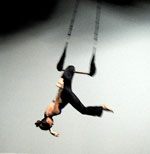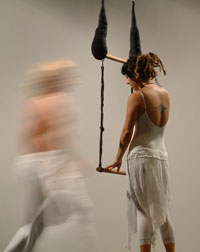
Dancers will leap from sidewalks of Tucson
to Brazilian landscapes
Friday, 20 November 1998
By Gene Armstrong
THE ARIZONA DAILY STAR
The two major works that comprise the new show
by O-T-O Dance will take viewers from downtown Tucson to the beaches
and jungles of Brazil.
The first half of the program - seen during
yesterday's matinee for schoolchildren - is a new version of artistic director
Anne Bunker's ``Urban Gaits,'' last seen a year ago. It has been pared from an
evening-length, two-act work to a 55-minute piece that features 10 sections
and 14 child and adult dancers.
This incarnation is shorter but now occurs during
one sitting. This demands patience from the audience. But Bunker's vision of
Tucson's urban landscape and lifestyles is worth the time.
Much of Bunker's choreography follows the
pattern of rhythmic tribal rituals, especially when business-suited dancers
stride purposefully, armed with requisite briefcases. We are, after all, a
unique tribe in the Old Pueblo. This is further emphasized by a scene in which
poet Charles Alexander gathers both children and adults around him to carry on
the oral tradition of storytelling with a prose poem about street life. While
the dances unfold, singers Craig Oakes and Amy Chapman Smith sing endlessly
intriguing lyrics written by Alexander to illustrate the various settings.
They are accompanied by an electronic score by O-T-O executive director and
technical guru Chuck Koesters. The sum effect recalls the art-song cycle of
Philip Glass' ``Songs From Liquid Days.''
Large-screen projections of videography by
Nancy Solomon and Koesters play across the back wall, depicting well-known
cityscape landmarks and icons. These images are alternately obscured and
framed by the four fixed-point trapezes on which the dancers often escape from
the gravity of the floor choreography. ``Urban Gaits'' also incorporates
moments of innocent play, poverty, spiritual reverence, terror and renewal.
The result isn't quite as multifaceted as an entire city, but it makes for a
remarkable and memorable dance work.
The premiere of the 35-minute
``Bridging Worlds'' is a collaboration between
O-T-O and the local group Capoeira Malandaraem. The Brazilian art of capoeira is an elegant, semi-improvisational
combination of acrobatics, dancing and martial arts. Choreographed by leader
Dondi Marble, the low-to-the-ground movements of the capoeristas alternate
with Bunker's expressive, animalistic choreography. The capoeira movement
vocabulary is unique: hands lightly patting the ground, dizzying kicks, leg
sweeps, low crouches and lunges, splayed-legs back flips and one-armed
somersaults. Just when a viewer might suspect that O-T-O' use of trapezes is
becoming a repetitive crutch, Bunker places dancers on them like jungle
animals perched in high branches.
Later, dancers move the four trapezes to swing
like pendulums to the percussive plink of the Brazilian bermibau, an
instrument made from a gourd, a long, curved neck and one stretched wire that
is tapped and muted by the player. Capoeristas Giovanni Dominice and Chris
Berry at one point play live conga drums and berimbau, adding to a recorded
score composed by Marble, Koesters and Guilherme Franco. Although the O-T-O
dancers execute bewitching choreography - the cocked-head lizards are
especially charming - they eventually begin to borrow from the movements
of the capoeristas. The cultural melding is not seamless, but it's satisfying.
Featured prominently and deserving of praise
are talented, expressive O-T-O dancers such as Bunker, Charles Thompson, Cora Kannel, Nicole Buffan and
O-T-O associate director Beth Braun.
Back to Top |


